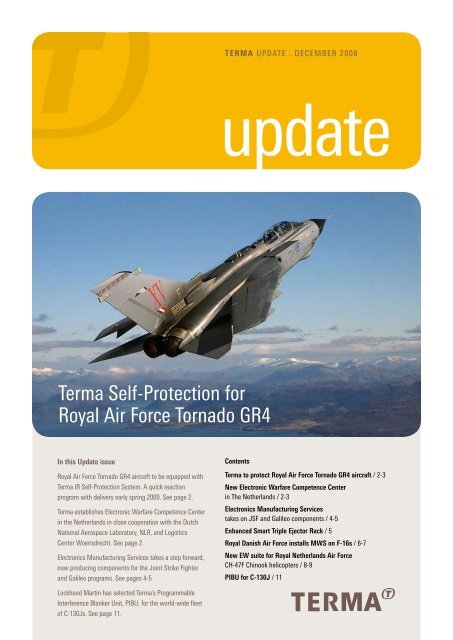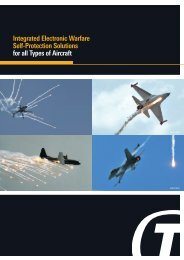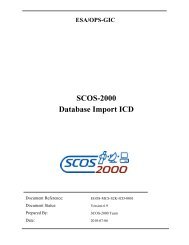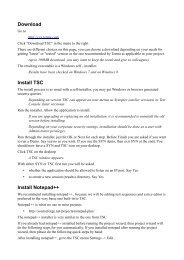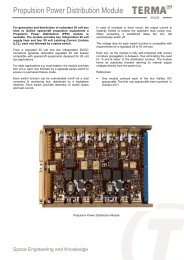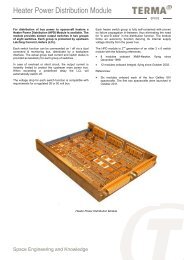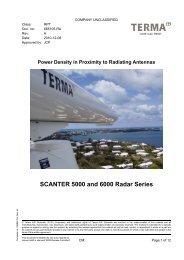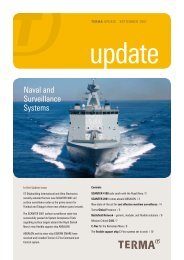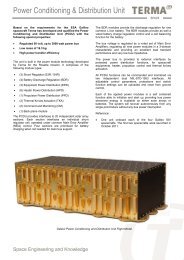December 2008 - terma
December 2008 - terma
December 2008 - terma
You also want an ePaper? Increase the reach of your titles
YUMPU automatically turns print PDFs into web optimized ePapers that Google loves.
Terma Self-Protection for<br />
Royal Air Force Tornado GR4<br />
In this Update issue<br />
Royal Air Force Tornado GR4 aircraft to be equipped with<br />
Terma IR Self-Protection System. A quick reaction<br />
program with delivery early spring 2009. See page 2.<br />
Terma establishes Electronic Warfare Competence Center<br />
in the Netherlands in close cooperation with the Dutch<br />
National Aerospace Laboratory, NLR, and Logistics<br />
Center Woensdrecht. See page 2.<br />
Electronics Manufacturing Services takes a step forward,<br />
now producing components for the Joint Strike Fighter<br />
and Galileo programs. See pages 4-5<br />
Lockheed Martin has selected Terma’s Programmable<br />
Interference Blanker Unit, PIBU, for the world-wide fleet<br />
of C-130Js. See page 11.<br />
TERMA UPDATE . DECEMBER <strong>2008</strong><br />
update<br />
Contents<br />
Terma to protect Royal Air Force Tornado GR4 aircraft / 2-3<br />
New Electronic Warfare Competence Center<br />
in The Netherlands / 2-3<br />
Electronics Manufacturing Services<br />
takes on JSF and Galileo components / 4-5<br />
Enhanced Smart Triple Ejector Rack / 5<br />
Royal Danish Air Force installs MWS on F-16s / 6-7<br />
New EW suite for Royal Netherlands Air Force<br />
CH-47F Chinook helicopters / 8-9<br />
PIBU for C-130J / 11
Terma to Protect Royal Air Force<br />
Tornado GR4 Fighter Aircraft<br />
Terma has been awarded a contract<br />
by BAE Systems to provide Advanced<br />
Infrared Protection Systems for the<br />
Royal Air Force Tornado GR4 Fighter<br />
Aircraft.<br />
The Tornado GR4 is an advanced<br />
ground attack aircraft, capable of<br />
operating during all light and weather<br />
conditions and delivering a large array<br />
of conventional and precision guided<br />
munitions. It can also be equipped<br />
with an advanced reconnaissance<br />
system, contained in the RAPTOR pod.<br />
For active self-defense the GR4 is<br />
equipped with two AIM-9L Sidewinder<br />
Missiles, and for self-protection it will<br />
now be equipped with Terma’s<br />
advanced infrared protection system.<br />
This system is based on the Terma<br />
Modular Countermeasures Pod, MCP,<br />
that is operational on several other types<br />
of aircraft in the UK, the Netherlands<br />
Terma Electronic Warfare Competence<br />
Support Center in the Netherlands<br />
Based on Terma Airborne Systems'<br />
more than 20 years of close relations<br />
and cooperation with the Royal<br />
Netherlands Air Force and the Dutch<br />
Aerospace Laboratory, NLR, Terma<br />
has decided to establish a European<br />
Electronic Warfare Competence<br />
Center in the Netherlands.<br />
2 TERMA UPDATE . DECEMBER <strong>2008</strong><br />
and Germany. The pod for the Tornado<br />
GR4 is a derivative of the MCP which<br />
accommodates missile warning sensors<br />
and flare dispensers for the high speeds<br />
and loadings connected with operating<br />
the Tornado GR4.<br />
Since the flight time of an attacking<br />
infrared guided missile may be very<br />
short indeed, only a few seconds, it is<br />
essential that countermeasures action is<br />
taken automatically and without delay.<br />
Terma’s Electronic Warfare<br />
Management System, AN/ALQ-213(V),<br />
is well proven and ideally suited for this<br />
purpose. Not only does it ensure<br />
automatic and timely flare dispensing, it<br />
also ensures integration with other EW<br />
self-protection systems and with aircraft<br />
avionics, and it gives the pilot the<br />
necessary visual and audio warnings.<br />
BAE Systems has been selected by the<br />
Royal Air Force to integrate the Terma<br />
Airborne electronic systems, such as<br />
electronic warfare equipment have a life<br />
span of many years, therefore requiring<br />
timely maintenance and upgrades to<br />
ensure reliable functionality and to meet<br />
evolving operational requirements.<br />
Terma’s support concept is therefore to<br />
be as close as possible to key customers<br />
Infrared Protection System on the<br />
Tornado GR4. According to the<br />
contract, delivery will take place in the<br />
early spring of 2009.<br />
The time between contract signature<br />
and delivery under this program is<br />
unusually short, the main reasons being:<br />
- Implementation of the program is<br />
characterized by a very open and trustful<br />
atmosphere between the involved parties,<br />
the RAF, BAE Systems and Terma.<br />
- Terma’s experience of many years in<br />
designing EW self-protection solutions<br />
based on previously developed core<br />
EW components such as the AN/<br />
ALQ-213(V) EW Management System,<br />
the Tactical Data Unit, the Modular<br />
Countermeasures Pod, and the<br />
Advanced Countermeasures<br />
Dispensing System with magazines,<br />
sequencers and EMI filters.<br />
in order to reduce time and cost<br />
connected with maintenance and<br />
upgrades.<br />
The first step in implementing this<br />
concept was taken in 2003, when<br />
Terma established a maintenance<br />
support center in Warner Robins,<br />
Georgia to support the large number
Electronic Warfare<br />
Management Unit, EWMU<br />
Tactical Data Unit, TDU<br />
Data loading/unloading, recording<br />
of Terma EW systems in service with<br />
the US Air Force. This facility has since<br />
grown into a separate company, Terma<br />
North America Inc.<br />
The Terma support facility in the<br />
Netherlands will be located at Logistics<br />
Center Woensdrecht in order to secure<br />
close coordination with the users and<br />
other maintenance facilities. The<br />
support center will be fully<br />
implemented in the spring of 2009. In<br />
the meantime, activities have been<br />
started up at the existing Terma BV<br />
Components for Tornado<br />
GR4 IR Protection<br />
Modular Countermeasures Pod (Sketch) for RAF Tornado GR4 with<br />
missile warning sensors and flare magazines. Modules can be<br />
rotated in 15 deg increments to obtain optimal firing direction.<br />
Digital Sequencer Switch for chaff<br />
& flare dispensing<br />
facility in Leiden and at the NLR<br />
facilities in Amsterdam.<br />
In the longer term, the intention is that<br />
the Terma Woensdrecht Support Center<br />
will also serve the users of Terma<br />
systems in other European countries.<br />
Agreement with NLR<br />
Terma considers it a great asset and a<br />
privilege to have entered into a<br />
cooperation agreement with NLR,<br />
signed in November of 2007. This<br />
agreement gives Terma access to NLR’s<br />
wide range of competencies within<br />
TORNADO<br />
Safety Switch/EMI Filter<br />
Dispenser Assembly/Magazine<br />
EW COMPETENCE CENTER<br />
research, development, testing,<br />
validation, certification, and to NLR’s<br />
facilities such as wind tunnels,<br />
simulators and research aircraft.<br />
This cooperation with NLR and with<br />
Logistics Center Woensdrecht enables<br />
Terma to offer to international<br />
customers complete turnkey solutions,<br />
which can be in the form of direct sales<br />
or through cooperation with Terma<br />
North America, where sales can be<br />
channeled through the US Foreign<br />
Military Sales system.<br />
TERMA UPDATE . DECEMBER <strong>2008</strong> 3
Terma Electronics Manufacturing Services<br />
in Leading International Programs<br />
With participation in programs such<br />
as Galileo and Joint Strike Fighter,<br />
Terma has proved its ability to cope<br />
with challenges at the highest<br />
technological levels.<br />
Terma has a tradition of many years of<br />
participating in international programs,<br />
notably the F-16, the Viggen, the<br />
AWACS and the SeaSparrow programs.<br />
With the added competencies from<br />
electronic warfare systems, power<br />
supplies, star trackers and x-band<br />
radar technology, Terma has a solid<br />
background for taking on even more<br />
challenging and sophisticated tasks<br />
within programs such as Galileo and<br />
Joint Strike Fighter.<br />
The Galileo Program<br />
Galileo is the European Global<br />
Positioning System, intended to match<br />
and even surpass the US and Russian<br />
GPS systems. The aim is to have a<br />
European system under civilian<br />
As shown in this illustration,<br />
Terma’s Electronics<br />
Manufacturing Services, EMS,<br />
focuses on products where<br />
formally documented quality<br />
assurance, program management<br />
and maturing of the product<br />
design are essential elements of<br />
the finished product.<br />
4 TERMA UPDATE . DECEMBER <strong>2008</strong><br />
control, with greater accuracy and<br />
with better coverage of the European<br />
area than the US system can offer.<br />
Galileo is a joint European Union/<br />
European Space Agency (EU/ESA)<br />
project. The total cost is estimated to<br />
be well over EUR 3 billion and the<br />
system is expected to be ready for<br />
operational use by 2013.<br />
Initially, Terma is to deliver power<br />
supplies to the satellites – an area<br />
Customer Terma<br />
TDP<br />
Parts Lists<br />
Drawings<br />
Schematics<br />
Specifications<br />
Configuration Management<br />
Registering of the TDP<br />
Assigning Customer Code<br />
Control of Documentation<br />
On-line Revision Control<br />
Production Engineering<br />
Test Set-Up<br />
Process Flow<br />
Routings<br />
Work Instructions<br />
where Terma has vast experience from<br />
previous satellite programs. However,<br />
in order to meet the even more<br />
stringent quality requirements for the<br />
Galileo project, it has been necessary<br />
to establish new state-of-the-art<br />
facilities, including an upgraded clean<br />
room environment and increased<br />
surface mounted devices assembly<br />
capacity and capability.<br />
Planning<br />
Generation of Parts Lists<br />
TERMA MRP System<br />
Production Plans<br />
Purchasing<br />
Manufacturing<br />
Quality Assurance
The Joint Strike Fighter Program<br />
It is still undecided which aircraft type<br />
will replace the F-16 for the Royal<br />
Danish Air Force. Even so, Denmark as<br />
a nation and Danish Industry, including<br />
Terma, are taking part in the<br />
development and initial production of<br />
this aircraft.<br />
Terma has developed and produced<br />
structural parts for the Joint Strike<br />
Fighter for quite some time, and this<br />
has now been expanded to also<br />
comprise electronic components such<br />
as modules for the radar, advanced<br />
wiring harnesses and power supplies<br />
for the flaps and rudder actuators.<br />
The Joint Strike Fighter and Galileo<br />
programs have made it possible for<br />
Terma to invest significantly in advanced<br />
electronics manufacturing processes,<br />
including advanced machinery,<br />
manufacturing technologies and IT<br />
support systems. These investments<br />
combined with the increased level of<br />
activity will result in a significant<br />
expansion of capacity and competencies.<br />
All in all, this technological upgrade<br />
makes Terma well prepared for the<br />
future, for the benefit of the customers<br />
of Terma’s Electronics Manufacturing<br />
Services.<br />
EMS ESTER<br />
Enhanced Smart<br />
Triple Ejector Rack<br />
One multi-carriage rack for the<br />
weapons of yesterday, today, and<br />
tomorrow<br />
The Enhanced Smart Triple Ejector<br />
Rack, ESTER, jointly developed by<br />
Terma and EDO, constitutes a unique<br />
carrier for legacy Mk-82/-83 iron<br />
bombs, current J-class weapons<br />
including GBU-49 and JDAM, and next<br />
generation stores, such as the Small<br />
Diameter Bombs.<br />
The basic requirement from the F-16<br />
MLU community was a multiple<br />
carriage of J-class weapons using<br />
aircraft BRU-57 software. The Terma/<br />
EDO team decided to expand the<br />
capability of the ESTER beyond these<br />
basic requirements, and by applying<br />
their combined capabilities, the<br />
TER-9/A, above and beyond the<br />
BRU-57, has been developed.<br />
The rack has only one hardware<br />
configuration which supports all three<br />
operation modes. These modes include:<br />
TER-9/A mode where the ESTER will<br />
operate identically to a TER-9/A<br />
carrying MK-82/-83 500 and 100 lbs<br />
iron bombs. The aircraft interface is<br />
identical to TER-9/A, and the<br />
RDAF F-16 equipped with<br />
Enhanced Smart Triple<br />
Ejector Rack, enabling it to<br />
carry up to three weapons<br />
under each pylon.<br />
operator will not experience any<br />
changes from<br />
a TER-9/A<br />
BRU-57 mode where the ESTER will<br />
interface with the aircraft as a<br />
BRU-57. The aircraft only needs<br />
BRU-57 software which will support<br />
carriage of two or three J-class<br />
bombs, such as JDAM and GBU-49<br />
ESTER mode where all the<br />
capabilities are utilized. The rack will<br />
carry up to three J-class weapons or<br />
Small Diameter Bombs, SDB, in class<br />
I or class II Universal Armament<br />
Interface as well as Launch<br />
Acceptability Region, LAR,<br />
calculations.<br />
For improved performance and reliability,<br />
the team has selected the Field<br />
Replaceable Connector System, FRCS, to<br />
replace the standard MIL type bomb<br />
interface connector on the J- and<br />
SDB-class bombs.<br />
The team has secured contracts with two<br />
customers for provision of hardware and<br />
services, and the first lot of prototypes<br />
has been delivered.<br />
Ground tests and initial flight tests were<br />
conducted successfully during the<br />
summer of 2007.<br />
TERMA UPDATE . DECEMBER <strong>2008</strong> 5
Royal Danish Air Force<br />
Installs MWS on F-16s<br />
In today’s asymmetric warfare, the<br />
F-16s often operate from forward<br />
deployment bases that may<br />
themselves be safe, but the corridors<br />
for take-offs and landings may<br />
provide potential hidings for<br />
launching of shoulderborne infraredseeking<br />
missiles which cannot be<br />
detected by the current F-16<br />
equipment. Therefore, to protect<br />
crew and equipment, the Royal<br />
Danish Air Force has decided to<br />
install integrated Missile Warning<br />
Systems, MWS, on its F-16 aircraft.<br />
6 TERMA UPDATE . DECEMBER <strong>2008</strong><br />
Missile Warning System Performance<br />
It is essential that a missile attack is<br />
detected as soon as possible and that<br />
false alarms are kept to a minimum. For<br />
this purpose, the RDAF has selected the<br />
EADS AAR-60(V)2 MILDS-F. This system<br />
is a fighter version of the MILDS system<br />
of which more than 4,000 units have<br />
been ordered. It is an ultraviolet-based<br />
system, characterized by low false alarm<br />
rate and a broad operational envelope,<br />
up to 45,000 feet+.<br />
Weapons Pylon Installation<br />
Three MWS sensors installed in each of<br />
the weapons pylons on stations 3 and 7<br />
give a near-360 deg spherical coverage<br />
against missile attack, even with a full<br />
weapons load. A Terma-developed<br />
Countemeasures Signal Processor, CSP,<br />
correlates inputs from the sensors to<br />
avoid duplication of warning messages.<br />
The MILDS(V)2 version includes<br />
ruggedizing and repackaging of the<br />
sensors to fit into the limited space of<br />
the F-16 pylon. The software has been<br />
updated with vastly improved processing<br />
speed. Advantages of the pylon<br />
installation are reduced aircraft<br />
downtime for modification, reduced cost<br />
because of minimum impact on the<br />
airframe, and the possibility of sharing<br />
modified pylons across the F-16 fleet.<br />
Operating the Missile Warning and<br />
Countermeasures System<br />
The AAR-60(V)2 is integrated and<br />
controlled by Terma’s AN/ALQ-213<br />
Electronic Warfare Management System,<br />
EWMS, which receives the threat<br />
information. Based on the aircraft<br />
parameters, such as attitude, speed,<br />
altitude - and not least trial results - the<br />
EWMS selects the optimum flare<br />
F-16 wing pylon showing position of missile<br />
warning sensors. With six sensors a near<br />
– 360 deg spherical coverage is achieved.
dispense program. Dispensing is<br />
automatic, initiated by MWS sensor<br />
signals. To facilitate countermeasures of<br />
new generation missiles, additional<br />
dispensers have been integrated in the<br />
weapons pylons. Up to four additional<br />
dispensers can be installed, resulting in<br />
200 % additional capacity compared to a<br />
preblock 40 F-16.<br />
Reduced Reaction Time<br />
with 3-D Audio Warning<br />
Since the flight time for a missile may be<br />
as low as 3-7 seconds, immediate<br />
reaction is essential. Within this time<br />
frame countermeasures must be<br />
initiated, and the pilot must start evasive<br />
maneuvers. The pilot is warned against<br />
missile attack through a warning signal<br />
in his earphones from the direction of<br />
the attack. This enables him to initiate<br />
evasive maneuvering instinctively and<br />
without delay. This 3-D Audio Warning<br />
actually reduces reaction time by close to<br />
one second, corresponding to more than<br />
50 %. At the same time, the threat<br />
warning appears on the Advanced Threat<br />
Display, ATD. The 3-D Audio System and<br />
the ATD are part of the Terma-developed<br />
ALQ-213 EW Management System. They<br />
are fully integrated with aircraft avionics<br />
system and the Joint Helmet Mounted<br />
Cueing System, JHMCS, in a manner<br />
that compensates for aircraft maneuvers<br />
and head movements. The ATD is an<br />
advanced full color, night vision gogglecompatible<br />
display that provides a total<br />
picture of the EW situation, including<br />
status of all on-board EW systems.<br />
Aircraft Audio Management System<br />
The 3-D Audio Warning System is also<br />
part of the Terma-developed Aircraft<br />
Audio Management System, AAMS.<br />
The following are examples of<br />
additional applications that increase<br />
the pilot’s situational awareness and<br />
reduce his workload:<br />
In aircraft with two or more radios,<br />
each radio can receive from its own<br />
direction, thus making it possible for<br />
the pilot to distinguish between<br />
simultaneous transmissions.<br />
In a formation, a wingman can talk<br />
to his lead from his actual position,<br />
thus giving the lead an immediate<br />
clue to the wingman’s position.<br />
In case of aircraft malfunction, the<br />
warning panel can ‘speak’ to the<br />
pilot, alerting him to the situation.<br />
Active Noise Reduction, ANR<br />
The noise level in an aircraft cockpit can<br />
be very high. Levels of up to 114 dB<br />
have been measured. This means stress<br />
on the crew and risk of developing<br />
hearing damage. As part of the AAMS<br />
Terma has introduced a high<br />
performance Active Noise Reduction<br />
MWS<br />
The 3-D Audio system is fully compatible with<br />
the Joint Helmet Mounted Cueing System, JHMCS<br />
system, ANR, which significantly lowers<br />
the noise level perceived by the pilot.<br />
This eliminates the need for earplugs<br />
and allows for reduced volume of the<br />
intercom system. The result is reduced<br />
pilot fatigue and stress levels.<br />
F-16 MWS Integration Contract<br />
Terma received the integration contract<br />
from the RDAF in late 2004, and design<br />
and manufacturing are progressing as<br />
planned. The first phase of the program<br />
focused on data collection of the F-16<br />
physical and operational environment.<br />
These data have been used for<br />
designing sensor hardware and<br />
software as well as pylon installation.<br />
The sensors have been installed to<br />
optimize coverage against the most<br />
likely attack directions. The first flight<br />
tests of the AAR-60(V)2 were performed<br />
in late 2007 and early <strong>2008</strong>. The system<br />
is now being certified by the USAF Seek<br />
Eagle office. The complete system will<br />
then be operational and ready for the<br />
F-16 Midlife Update M5 software.<br />
TERMA UPDATE . DECEMBER <strong>2008</strong> 7
New Modular Aircraft Survivability Equipment<br />
for the Royal Netherlands Air Force CH-47F<br />
Chinook Helicopters<br />
Building on the experience from the<br />
AMASE program for the Dutch<br />
Apache helicopters, Terma and the<br />
Royal Netherlands Air Force have<br />
developed a similar solution for the<br />
new Chinook, CH-47F, soon to be<br />
delivered to the RNLAF. The system<br />
has been labeled CHASE for Chinook<br />
Aircraft Survivability Equipment.<br />
8 TERMA UPDATE . DECEMBER <strong>2008</strong><br />
The Dutch Defence Materiel<br />
Organisation, DMO, and Terma jointly<br />
decided on a pod solution for<br />
installation and integration of DIRCM,<br />
Directional Infrared Countermeasures,<br />
with a laser beam to divert attacking<br />
missiles. The DIRCM system is<br />
manufactured by Northrop Grumman.<br />
Initial flight tests were carried out in<br />
July 2007, and final delivery will take<br />
place as an integrated part of Boeing’s<br />
delivery of the new helicopters during<br />
<strong>2008</strong> and onwards. The illustration on<br />
the opposite page shows the initial<br />
mechanical integration of the CHASE<br />
pod on the CH-47D. It gives a good<br />
impression of the final pod solution.<br />
Full 360 deg spherical coverage
CHASE in detail:<br />
The Chinook will carry two CHASE<br />
pods installed on each side of the<br />
helicopter. Each pod contains three<br />
missile warning sensors and one laser<br />
turret. The pods are mounted directly<br />
on the helicopter main frame to<br />
minimize dynamic in-flight impact,<br />
which could otherwise cause optical<br />
sensor distortion.<br />
The six-sensor solution provides a 360<br />
deg spherical coverage against missile<br />
attack as shown on the sketch to the<br />
left. The collocation of the sensors and<br />
the DIRCM in the same pod ensures<br />
easy mechanical integration, which is<br />
of utmost importance to the overall<br />
performance of the system with<br />
respect to the level of false alarms and<br />
handover from one laser turret to the<br />
other. Installation of sensors elsewhere<br />
on the fuselage would have to deal<br />
with airframe twist, which on a CH-47<br />
can be significant during extreme<br />
maneuvers – an effect which causes<br />
misalignment between the sensors and<br />
the DIRCM system, which again results<br />
in distortion of overall performance and<br />
an increasing number of false alarms.<br />
From an overall view, operational,<br />
technical as well as economic, the<br />
CHASE solution provides the following<br />
advantages, similar to those of the<br />
AMASE solution:<br />
Minimum impact on aircraft<br />
modifications, and thus downtime<br />
for the upgrade<br />
CHASE<br />
Easy and cost-effective routes for<br />
future technical upgrades, such as<br />
active jammers<br />
Possibilities of sharing of CHASE<br />
units across the Chinook fleet<br />
rather than each helicopter being<br />
fully equipped.<br />
Illustration showing the installation of the CHASE Pod which hosts all of the<br />
missile warning sensors and laser-based Directional Infrared<br />
Countermeasures, DIRCM.<br />
To attain the required static and dynamic accuracy, the CHASE pods are<br />
mounted on both sides of the helicopter.<br />
The sensors and DIRCM system, together with the ACMDS system, will be<br />
controlled by the ALQ-213A EW Management System installed as an<br />
integrated part of the CH-47 suite and cockpit.<br />
TERMA UPDATE . DECEMBER <strong>2008</strong> 9
Terma Develops New Version of the ALQ-213<br />
The ALQ-213, Electronic Warfare<br />
Management System, was originally<br />
developed in the early nineties. Over<br />
the past fifteen years, it has gone<br />
through a large number of upgrades<br />
and add-on’s. Terma has therefore<br />
taken the natural next step,<br />
combining these improvements and<br />
additional units into a new version<br />
called AN/ALQ-213A(V) Defensive<br />
Aids Controller, DAC.<br />
Like its predecessor, the ALQ-213A,<br />
DAC is a universal controller, that will<br />
integrate and control any combination<br />
of EW subsystems into any type of<br />
aircraft. The ALQ-213A combines the<br />
functionalities of the EW Management<br />
Unit, the Tactical Data Unit, the<br />
Programmable Interference Blanking<br />
Unit, and the Countermeasures Signals<br />
Terma is awarded contracts to deliver<br />
major parts of the Radar System<br />
Improvement Program, RSIP, for the<br />
Japanese 767 AWACS fleet.<br />
RSIP increases the radar sensitivity of<br />
the AWACS aircraft, allowing it to<br />
detect and track smaller targets. It also<br />
improves the radar’s existing computer<br />
with a new high-reliability multiprocessor<br />
and rewrites the software to<br />
facilitate future maintenance and<br />
enhancements.<br />
The RSIP kit, built by Terma for<br />
Northrop Grumman Electronic<br />
Systems, Baltimore, MD, under a<br />
10 TERMA UPDATE . DECEMBER <strong>2008</strong><br />
Processor into one single unit that can<br />
be operated from Terma’s Advanced<br />
Threat Display or from an existing<br />
mission display, MPD or MFD.<br />
The ALQ-213A makes use of the latest<br />
novel and sophisticated technology,<br />
including additional processing power<br />
and memory capacity, inertial<br />
measurements, time and position,<br />
Advanced Threat Display+<br />
Controls for ALQ-213A<br />
AN/ALQ-213A (V)<br />
New RSIP for AWACS Japan<br />
subcontract to Boeing, consists of a<br />
new radar computer, a radar control<br />
maintenance panel, and upgrade of<br />
other electronic units.<br />
The RSIP upgrades will improve E-767<br />
surveillance capability by increasing<br />
the Pulse Doppler radar sensitivity and<br />
enables the aircraft to detect and track<br />
smaller targets. It also improves the<br />
radar’s electronic countermeasures,<br />
human-machine interface, and<br />
reliability and maintainability.<br />
RSIP kits built by Terma have been<br />
installed on the US, UK, NATO, and<br />
French AWACS fleets. The 767 AWACS<br />
program takes advantage of modern<br />
provisions for special interfaces, and at<br />
the same time, significantly lower weight.<br />
The launch customer for the ALQ-213A<br />
will be the Royal Netherlands Air Force<br />
for the new CH-47F Chinook helicopters,<br />
where it will control the entire EW suite<br />
including the Terma-developed Chinook<br />
Aircraft Survivability Equipment, CHASE<br />
(see article on page 8).<br />
EW Management Unit<br />
(EWMU)<br />
Tactical<br />
Data Unit (TDU)<br />
ALQ-213<br />
Programmable<br />
Interference<br />
Blanking Unit (PIBU)<br />
Countermeasures Signals<br />
Processor (CSP)<br />
AWACS<br />
manufacturing facilities and processes<br />
which ensure a high-quality Boeing<br />
defense product.<br />
The basic 767 airplane is manufactured<br />
by the Boeing Commercial Airplane<br />
Group in Everett, WA, and is modified<br />
to accommodate the prime mission<br />
equipment.<br />
Production of the first derivative<br />
airframe was completed in October<br />
1994. First flight with the rotodome<br />
installed occurred in August 1996.
Programmable Interference Blanker Unit<br />
for C-130J Block 7 Aircraft<br />
Terma has been selected by Lockheed<br />
Martin to provide 254 Programmable<br />
Interference Blanker Units, PIBUs, for<br />
C-130J aircraft to be delivered to nine<br />
countries.<br />
This contract award to Terma can be<br />
seen as a recognition of Terma’s<br />
qualifications in this special area, where<br />
Terma by request had already developed<br />
a Programmable Interference Blanker<br />
Unit for the Danish C-130Js.<br />
The necessity for a PIBU stems from<br />
the numerous receivers and<br />
transmitters on board the airplane:<br />
radios, radars, jammers, and other<br />
electronic warfare systems, where<br />
interference and degraded performance<br />
would be a serious problem unless<br />
corrective action was taken. As an<br />
example, the PIBU will shut down the<br />
Radar Warning Receiver as long as<br />
jamming takes place. Since receivers<br />
are being blinded when blanking is in<br />
effect, it is essential that the duration<br />
of the blanking is minimized. The<br />
blanking period is typically in the range<br />
of a few microseconds.<br />
The programmable feature of the unit<br />
ensures that the PIBU can easily be<br />
reprogrammed in accordance with<br />
upgrades or changes in aircraft<br />
configuration. Furthermore, a late<br />
optimization of the blanking ”scheme”<br />
is achieved, thereby reducing the risk<br />
PIBU<br />
and integration effort by allowing<br />
programmable correction of actually<br />
measurable interferences, thus avoiding<br />
costly updates of hardwired schemes.<br />
Although pricing is always a factor, the<br />
impression is that among the available<br />
suppliers, Terma was selected primarily<br />
because of the proven performance and<br />
the maturity of the Terma PIBU.<br />
The delivery has two phases. Nine trial<br />
kits will be delivered in 2009 and 2010.<br />
The remaining sets, up to the total of 254,<br />
will be delivered from 2012 onwards.<br />
As part of the agreement, a PIBU<br />
maintenance facility will be set up at<br />
Terma’s site in Warner Robins, Georgia<br />
in order to keep the repair turnaround<br />
within 30 days.<br />
TERMA UPDATE . DECEMBER <strong>2008</strong> 11
Financial Highlights<br />
Terma develops and markets high-tech solutions, systems,<br />
and products for civilian and military applications.<br />
Terma’s high-tech solutions and products are developed and designed<br />
for use in extreme mission critical environments and situations, where<br />
human lives and valuable material assets are at stake.<br />
In Denmark, Terma facilities are located at Aarhus, Copenhagen,<br />
and Grenaa.<br />
Terma’s international locations include Leiden, the Netherlands;<br />
Darmstadt near Frankfurt, Germany; Washington, DC; and Warner<br />
Robins, GA, USA; and Singapore.<br />
Terma A/S was established in 1949. For years, Terma has worked<br />
closely with defense forces, public authorities, and international<br />
organizations around the world. Through these relationships, Terma<br />
has gained in-depth knowledge of and insight into our customers’<br />
working environment and an equally deep understanding of their<br />
situations and needs.<br />
Terma is fully owned by the Thomas B. Thrige Foundation.<br />
TERMA IN BRIEF<br />
We Provide Mission Customized Solutions<br />
TERMA UPDATE . DECEMBER <strong>2008</strong> Editor Kasper Rasmussen, kar@<strong>terma</strong>.com<br />
Terma A/S<br />
Hovmarken 4<br />
8520 Lystrup<br />
Denmark<br />
T +45 8743 6000<br />
F +45 8743 6001<br />
www.<strong>terma</strong>.com<br />
Terma A/S<br />
Fabrikvej 1<br />
8500 Grenaa<br />
Denmark<br />
T +45 8743 6000<br />
F +45 8743 6001<br />
USD million 2007/08 2006/07 2005/06 2004/05 2003/04<br />
Sales 195 171 165 202 183<br />
Profit for the year before tax 18 14 12 14 12<br />
Equity Capital, year-end 83 62 57 57 53<br />
Assets, total 215 173 151 167 189<br />
Order intake 270 163 166 189 145<br />
Order book, year-end 325 227 227 228 241<br />
Number of full-time employees<br />
– Average for the year 1,020 965 1,014 1,034 1,010<br />
Terma A/S<br />
Vasekær 12<br />
2730 Herlev<br />
Denmark<br />
T +45 8743 6000<br />
F +45 8743 6001<br />
Terma’s business areas cover:<br />
Aerostructures for Aircraft<br />
Airborne Systems, including<br />
– Self-Protection Systems for Aircraft<br />
– Audio Systems Solutions<br />
– Reconnaissance Systems for Fighter Aircraft<br />
– Electronics Manufacturing<br />
Integrated Systems, including<br />
– Self-Protection Systems for Naval Vessels<br />
– Command and Control Systems for Navy,<br />
Army, and Air Force Applications<br />
– Air Traffic Management Systems<br />
– Public Safety & Emergency<br />
Radar Surveillance Systems<br />
Solutions, Services, and Products for Space<br />
Applications<br />
Terma North America Inc.<br />
645 Tallulah Trail, Suite 204<br />
Warner Robins, GA 31088<br />
USA<br />
T +1 (478) 923 7233<br />
F +1 (478) 923 7360<br />
Terma North America Inc.<br />
2461 South Clark Street,<br />
Century Two, Suite 810,<br />
Arlington, VA 22202, USA<br />
T +1 (703) 412 9410<br />
F +1 (703) 412 9415<br />
idworks.dk 3981/11.08


